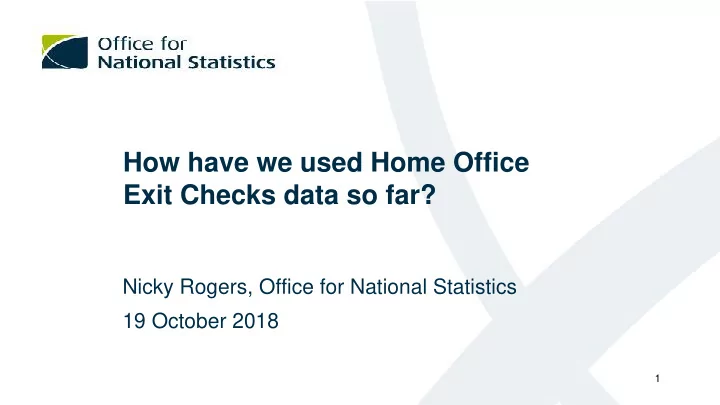

How have we used Home Office Exit Checks data so far? Nicky Rogers, Office for National Statistics 19 October 2018 1
Presentation outline • Non-EU international students – what do they do at the end of their studies? • Non-EU migration for work and family reasons – what do Exit Checks data tell us? 2
The Student Migration Issue (non-EU) Measures to Inflow for formal study improve compliance Inflow for study (confidence in Tier 4 route interval bounds) from 2010 onwards 300 Long-Term International Migration Flows 250 200 150 (thousands) 100 50 0 1991 1992 1993 1994 1995 1996 1997 1998 1999 2000 2001 2002 2003 2004 2005 2006 2007 2008 2009 2010 2011 2012 2013 2014 2015 2016p Year Source: International Passenger Survey • International students contribute around a quarter of total immigration to the UK • The International Passenger Survey (IPS) is used to estimate migration flows • In the year ending March 2017- total immigration for study was 139,000 and emigration of former students was 59,000, leaving a “gap” of 80,000 3
What we now know from Exit Checks data • Recent publications include: “What’s happening with international student migration?” – ONS “International student migration update” - ONS “Third report on statistics being collected under the exit checks programme” - Home Office • ONS’ analysis of Home Office Exit Checks data revealed that majority (90%) of non -EU international students either depart the UK before their visa expires, or extend their leave to remain • Our analysis suggests the IPS is underestimating long-term non-EU student emigration figures 4
What our initial analysis of Exit Checks data gave us… • A better understanding of how international students contribute to net migration • BUT not sufficient evidence to suggest findings affect TOTAL net migration figures • Only part of the picture… 5
What we did next – work and family migration (non- EU) Improve our assumptions and methods - do these hold for other types of migrants? ✓ Visa length is a proxy for length of stay ✓ Explore family visas in more detail ✓ First arrival after departure is an indicator of length of time away Develop methods to identify long-term immigrants on study, work, family-related and other visas 6
Visa Length as a proxy of length of stay Tested by calculating revised length of stay using duration from first recorded arrival date and last departure date (when available) Arr. Dep. Arr. Dep. Arr. Dep. VALID VISA PERIOD First arrival Last departure But it doesn’t tell us about an individual’s travel pattern in between these two points in time…. 7
Length of stay as a proportion of visa length 8 Source: ONS analysis of Home Office administrative data. Cohort with visas expiring between April 2015 and April 2016
Average number of visits and average length of visit Visa Length Average number Average length of of visits visit (days) Less than 1 year 2.0 75.8 1 to 2 years 3.9 83.8 2 to 3 years 6.6 80.1 3 to 4 years 8.5 82.6 4+ years 8.7 115.6 Non-EU migrants often make multiple journeys to and from the UK. The shorter the visa, the fewer the number of visits Source: ONS analysis of Home Office administrative data. Cohort with visas expiring April 2017 and April 2018. 9
Non-EU migrants often make multiple journeys to and from the UK Number of Percentage of Total number journeys of journeys of journeys 90 days or 90 days or away from UK more more 1,491,000 197,000 13% Source: ONS analysis of Home Office administrative data. Cohort with visas expiring April 2017 and April 2018. 10
Comparing data sources (2016/17) Important points to note: • Data sources are not capturing the same information and are not used for the same purpose. • Differences due to type of data collected, how the data are collected, data quality of the two sources, assumptions made to process these data. 11 Source: ONS analysis of Home Office administrative data and International Passenger Survey (IPS) data. Cohort with visas expiring 2016 and 2017
Using Home Office administrative data to understand international migration – what we learnt • People’s lives are complex – migration patterns are changing as migrants move more frequently (circular migration) • These movements do not conform neatly to our traditional statistical definitions of migration • No single source of data reflects this complexity. There is more work to do integrating data sources to better understand migration patterns 12
If you want to read more about this… https://www.ons.gov.uk/peoplepopulationandcommun ity/populationandmigration/internationalmigration/artic les/reportonthecomplexityandqualityofinternationalmi grationstatistics/july2018 Or search for: Report on international migration data sources, ONS July 2018 13
What’s next with Home Office administrative data? • Continue our collaboration with Home Office experts to better understand the data • Develop methods to identify, classify and analyse different types of international migrants • Further work looking at circular migration • Linkage to other sources to provide international migration flows (non-EU and EU) • Link HESA data - emigration of former students by LA • Link to tax and benefit data – ‘signs of activity’ and impact on economy 14
Recommend
More recommend